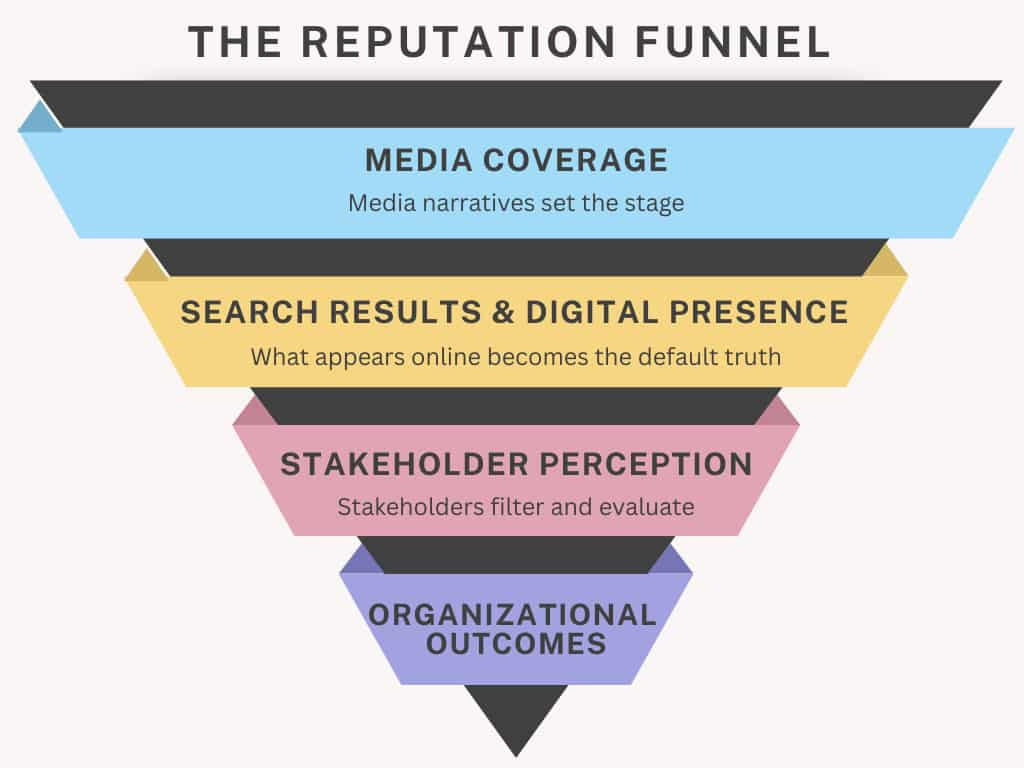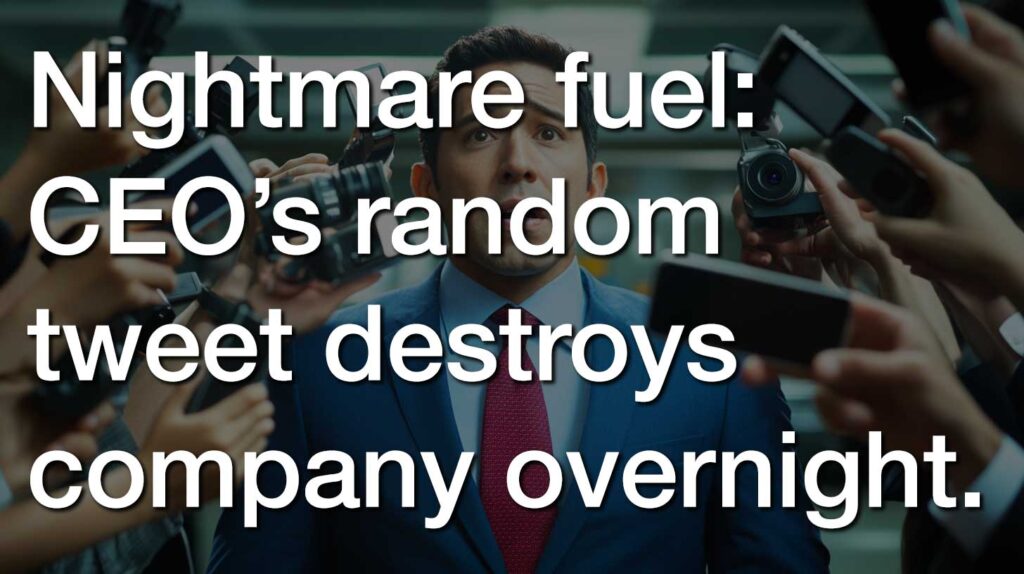Effective Reputation Management for Leaders and Founders

Have you ever Googled your name just to see what shows up? If so, you’re not alone—56% of people have. Most leaders and founders probably exceed that number. It’s that moment where you realize how much of your life is on display and, honestly, how little control you seem to have over what people say about your legacy. One unflattering headline, a bad review, or even an outdated photo can feel louder than years of hard work. If you have a Wikipedia article it can be even worse unless curated carefully. When your personal reputation is tangled up with your company’s success, the stakes couldn’t be higher.
Reputation management for leaders isn’t about micromanaging every mention of your name—it’s about shaping how you’re perceived. Trust, credibility, and leadership feel more public than ever before, and the way you handle it all leaves a lasting impression. But here’s the catch: managing your reputation as a person is not the same as managing a corporate brand. There’s nuance, vulnerability, and an entirely different set of expectations involved when managing the reputation of a human.

This article takes a closer look at what “reputation management” really means when you’re the one at the helm of the ship. Whether you’re responding to criticism, building a digital presence, or balancing personal and corporate identities, understanding the strategies behind effective reputation management can make the difference between being seen as a trusted leader or a cautionary tale. If you’ve already explored the broader connections between leadership and corporate reputation in our Ultimate Guide, this is your chance to go deeper into the specific challenges—and opportunities—that leaders and founders face every day.
Key Points of This Article
- Reputation management for leaders is personal. Unlike managing a corporate brand, controlling your own narrative involves navigating trust, vulnerability, and public perception with care. It’s less about spinning a perfect image and more about fostering transparency that resonates with your audience. Being authentic can carry more weight than being flawless.
- Your personal reputation and your company’s image are interconnected. Think of it like a dance—your steps as a leader set the rhythm for how your organization is perceived. One misstep in your personal brand can ripple outward, impacting your business. At Reputation X we deal with this often. Mastering this balance means carefully curating your presence.
- An effective online presence is your foundation. From a polished LinkedIn profile to an engaging blog, your digital footprint should reflect both your expertise as well as your personality. It’s not just about broadcasting accomplishments—it’s about telling a story that builds trust, inspires confidence, and leaves a lasting and hopefully positive impression.
- Criticism isn’t the end; it’s an opportunity. Imagine a bad review or negative news story as a storm cloud—it might cast a shadow temporarily, but how you respond determines whether you weather the storm or get swept away. Addressing feedback head-on, with grace and accountability, can actually enhance your reputation over time – though it may not feel like it in the moment.
- Privacy and security are non-negotiable. Leaders and founders are increasingly often targets for misinformation and data breaches, making it imperative to safeguard personal and professional information. A proactive approach to digital security not only protects your reputation but also reinforces your credibility as a responsible leader.
- Building and managing your reputation is an ongoing journey. It’s not a one-and-done effort but a continuous process of self-awareness, adaptation, and growth. Regularly monitor how you’re perceived, respond to changes in sentiment, and integrate reputation management into your broader leadership strategy for long-term success.
Differences Between Individual and Corporate Reputation Management
For leaders and founders, understanding how personal reputation differs from corporate reputation is a big part of navigating public perception effectively. While these two dimensions overlap, each presents unique challenges. Individual reputation management revolves around a leader’s values, personal image, and behavior, while corporate reputation extends to an organization’s brand, operations, and stakeholder trust. Recognizing these distinctions helps leaders maintain a cohesive narrative that that reflects both sides, personal identity and corporate identity.
Unique Challenges Faced by Leaders and Founders
Leaders and founders operate under intense scrutiny, where personal decisions often carry professional implications. For example, one misstep in your off-hours, can ruin your professional life. Unlike organizations that can distribute accountability, a leader’s actions, words, and affiliations are directly tied to their own reputation. For example, a founder voicing a controversial opinion on social issues (and being videotaped) may unintentionally polarize their audience, creating ripple effects for their company’s brand equity. At that point the Board of Directors may decide to sacrifice the leader to save the company.
Additionally, leaders often face the challenge of blending their personal values with corporate values. I grew up around Patagonia, so I will use that example. A prominent example is Patagonia’s founder, Yvon Chouinard, whose personal advocacy for environmental sustainability became the backbone of the brand’s identity. While this alignment boosted Patagonia’s global reputation, it also placed the company under heightened pressure to meet lofty environmental standards, exemplifying the dual-edged nature of intertwining personal and corporate reputations.
Leaders must also manage the permanence of online content–not always easy. A tweet that misfires (ask Guardians director James Gunn) or an offhand comment captured on video can dominate headlines. The unforgiving nature of the internet magnifies the stakes for founders and underscores the importance of careful reputation management.
Interplay Between Personal and Company Reputation
The connection between a leader’s reputation and their organization’s public image is inseparable. A strong personal reputation can enhance corporate trust and draw attention to initiatives, but missteps can just as easily damage a brand. Consider Tesla CEO Elon Musk: his dynamic and polarizing persona has significantly bolstered Tesla’s visibility and appeal among certain audiences, yet his controversial tweets and public statements have also led to stock volatility and regulatory challenges. This symbiotic relationship highlights the delicate balance leaders must maintain.

To harmonize these reputational spheres, leaders should craft a personal narrative that aligns with their company’s values–unless they just don’t seem to care. Practical steps include ensuring public remarks align with the organization’s vision and leveraging company communication teams to refine and amplify messaging consistently across platforms as well as keeping an eye on both the personal and professional aspects of the leaders online discourse.
Examples Showcasing These Differences
Real-world scenarios emphasize the differences between managing individual and corporate reputations. In 2021, for example, the CEO of a startup in the health-tech space faced allegations of workplace misconduct. While the company quickly released a formal statement to address the situation, the leader’s personal silence on the matter prolonged the media storm, raising concerns about their accountability and leadership integrity. This illustrates is the unique burden on leaders to directly manage personal reputation fallout beyond corporate damage control.
Conversely, corporate crises can also shape personal reputations. When Johnson & Johnson faced its infamous Tylenol crisis in the 1980s, then-CEO James Burke’s proactive and transparent handling of the situation not only safeguarded the company’s reputation but also burnished his personal image as an ethical and decisive leader. See, opportunity. This strategic response could be a blueprint for leaders seeking to align their own credibility with that of their organization.
Navigating the differences between individual and corporate reputation management requires a tailored approach that considers these interconnected dynamics. Leaders who proactively address reputation protection in their communication strategies will find themselves better positioned to cultivate both personal and corporate trust.
For a broader exploration of corporate brand strategies, see “The Ultimate Guide to Corporate and Executive Reputation”, which delves further into aligning personal leadership with organizational success.
The Reputation Funnel: How Leadership Perception Is Formed
A leader’s reputation doesn’t develop in a vacuum. It moves through stages, much like a funnel. At each level, signals are amplified, filtered, or reinterpreted before they impact the organization itself.

Media Coverage (Top of Funnel)
Reputation often starts with media narratives — news articles, interviews, and press coverage. Traditional outlets remain powerful agenda-setters. In fact, studies show legacy media still outweighs social media in shaping corporate reputation, even when coverage is negative.
Search Results & Digital Presence (Middle of Funnel)
Once a story is published, it is indexed by Google, LinkedIn, Wikipedia, and review sites. Since 95% of people never click beyond page one, the search experience largely determines what stakeholders believe.
Stakeholder Perception (Lower Funnel)
Employees, investors, regulators, and customers interpret what they see in the media and online. Research shows reputation is fundamentally an evaluator’s judgmen. Rather than being based on what the leader says, reputation is what others conclude.
Organizational Outcomes (Bottom of Funnel)
The perception of the leader ultimately drives outcomes:
- Talent: 69% of job seekers reject offers from companies with poor reputations.
- Performance: Positive reputation supports higher revenue and investor trust.
- Loyalty: Customers stay (or walk away) based on the trustworthiness of leadership.
Core Components of Reputation Management for Leaders
Managing reputation as a leader can be summed up as follows:
Strategic Online Presence
A leader’s online presence often serves as the first impression for stakeholders, ranging from potential investors and employees to customers and media. A strategic, well-maintained online footprint signals professionalism and authority.
Start by prioritizing platforms that tend to rank well for executives like LinkedIn and personal websites. For example, a polished LinkedIn profile that highlights accomplishments, values, and thought leadership can establish expertise in your industry, but it will also rank on the first page of a Google search and be used by AI-based search engines as an information source. Personal blogs or op-eds are another avenue to articulate your perspectives on critical topics, building your identity as an influential voice and to act as a lever to protect reputation should something go awry.
Consistency is key. Ensure that your online narrative aligns with your corporate goals and values. For instance, if sustainability is a core company priority, your posts, articles, and public communications should consistently reinforce this message. At Reputation X, we call this cultivating corporate mythology. Regularly audit your online presence for outdated content, inconsistent messaging, or visuals that no longer represent your brand (because Journalists will use these against you).
Proactive Media Engagement
Engaging proactively with the media is clearly a good idea for maintaining visibility and controlling the narrative. Leaders should view interviews, press releases, and thought leadership pieces not just as opportunities to promote their company but to also humanize their leadership.
For example, Satya Nadella, CEO of Microsoft, has successfully used media appearances to reinforce organizational changes under his tenure while showcasing his empathetic leadership style. This dual approach has strengthened his personal brand alongside Microsoft’s corporate image.

Cultivating relationships with journalists and industry influencers is equally important. By serving as a resource for reliable insights or expert commentary, you increase the likelihood of balanced and favorable coverage in times of success or crisis. Utilize public speaking events, podcasts, and webinars to further amplify your voice and expand your reach.
Managing and Responding to Public Feedback
Public perception isn’t static—it evolves based on how you handle praise and criticism alike. Engaging constructively with feedback, especially negative reviews or online criticisms, demonstrates accountability and transparency.
For example, if customers express dissatisfaction through social media, a leader who responds personally and offers a solution showcases both authenticity and care. OK, but who has time for this? Well, someone should do it. It could involve a short public acknowledgment—”We hear you”—followed by actionable steps, such as a policy change or a consultation with key stakeholders. Conversely, ignoring or mishandling complaints can cause issues to catch fire online, leading to reputational damage.
Leaders should also look for opportunities to turn feedback into growth. Use online conversations to identify emerging trends (Example: Reddt conversations about the company), resolve current issues, or improve products and services. Train teams handling online communications to embody your brand’s values in their responses to ensure consistency.
Digital Privacy and Security for Leaders
Leaders operate under a microscope, making digital privacy and security one of reputation management’s most overlooked components. A data breach can nuke a company’s reputation quickly.
Minimize vulnerabilities by protecting sensitive data with robust cybersecurity tools. Regularly update passwords, enable multi-factor authentication, and monitor accounts for unusual activity. Beyond technical safeguards, leaders must also proactively address misinformation or fake news targeting their persona. For example, deploying authoritative rebuttals directly from verified official accounts can mitigate inaccuracies before they spread widely.
Additionally, be cautious about what personal information you share online, and double-check who you invite to war planning sessions on Signal. Educating yourself and your teams on privacy best practices ensures that your online presence remains resilient against these risks.
Steps to Build and Maintain a Strong Leadership Reputation
A strong leadership reputation isn’t built overnight—it’s cultivated through deliberate actions and sustained efforts. To us, it’s curation. For founders and executives, reputation is an asset that directly influences stakeholder trust, team morale, and the broader perception of their organization. Here are some actionable steps leaders can take to build and maintain a clean and positive reputation while ensuring it aligns with their professional goals and organizational values.
Conducting a Reputation Audit
You have to measure something before you can improve it. Before making changes, leaders ought to first understand their current standing. A reputation audit involves evaluating how you’re perceived by stakeholders, employees, customers, and the public. Start by analyzing your digital footprint—search your name on Google (you’ve probably already done that), review social media mentions, Reddit, and assess any existing or recent news coverage.
Use tools designed for monitoring online sentiment, such as TalkWalker, Brand24, or Meltwater, to track mentions of your name and activity over time. Solicit direct feedback from your team and trusted advisors to gain more insights into how your leadership style is viewed internally. GlassDoor is a good place to find this information. For instance, an effective CEO might discover through an anonymous survey that while they excel at strategic vision, employees see room for improvement in day-to-day communication, or that employees would rather the leader be immediately abducted by aliens.
A clear sense of your current reputation lays the foundation for improvement.
Developing a Reputation Action Plan
So now you have conducted the audit, the next step is to map out your action plan. Begin by defining specific goals for your personal brand—are you aiming to be known as an industry innovator, a people-first leader, or a champion of sustainability? Having a clear vision will help guide your efforts. This is your online mythology.
Identify measurable key performance indicators (KPIs) to track progress, such as increased engagement with your LinkedIn posts or invitations to speak at niche conferences, positive sentiment in Reddit, better scores on GlassDoor, etc.
To structure your plan, think long-term but start small. If you’re a startup founder, dedicating only an hour each week to professional development or engaging with your audience online can begin to shift perceptions and strengthen your brand.
Continuous Monitoring and Improvement
Reputation management is not a one-time effort; it requires cultivation. It’s an organic thing. Leaders who actively monitor how they’re perceived are better equipped to pivot when it becomes necessary. Schedule quarterly reviews of your reputation audit metrics—pay attention to trends or recurring themes in feedback.
If public sentiment changes—for instance, due to an ambien-fueled controversial tweet or an external challenge—correct course early rather than letting issues escalate. Consider enlisting the help of communication professionals—like for example reputation consultants—if the intricacies of reputation curation become overwhelming.
Use these ongoing assessments to nurture your reputation over time. Consistency is the thing; a strong, well-maintained reputation becomes more resilient when tested by external pressures. Yeah, sounds like Nietzsche.
Integrating Reputation Management into Corporate Strategies
Leaders’ reputations are inevitably tied to the organizations they lead, particularly for founders and executives in the public eye. As seen in high-profile companies where CEOs embody the brand’s values aligning personal values with corporate messaging creates authenticity. But that can be tough. It’s not fun to have to be a “boy scout” 24/7. But, it is worth keeping in mind as the blowback from missteps can be terrible.
Collaborate with your corporate PR or branding teams to ensure a unified voice. At Reputation X, we often recommend that leaders separate day-to-day private lives from a curated version. It’s not a lie, it’s a true reflection of the leader, just crafted more mindfully. In other words, stay off social media but for things that support the profile you want to build.
For instance, if your organization announces a corporate social responsibility initiative, amplify it through your own professional channels to reinforce alignment between personal and corporate reputations. But keep your friends list private when you can. When discrepancies exist between the two, it can lead to problems when a crisis hits.
Challenges Leaders Face in Reputation Management

Leaders and founders often stand at the complex intersection of personal integrity and organizational stewardship. Below, we delve into some of the common pitfalls and survival strategies for leaders working to maintain a positive and impactful reputation.
Common Pitfalls to Avoid
For leaders and founders, certain missteps in reputation management can escalate quickly, undermining not only their personal credibility but also the stability of their business. One frequent mistake is saying the wrong thing in public while someone is recording them.
Another pitfall is overreacting to negative press or public criticism. Leaders who publicly lash out at detractors—like issuing defensive statements too soon or engaging in online arguments—risk appearing unprofessional and emotionally reactive. A prime example is when Elon Musk, Tesla’s CEO, impulsively responded to shareholder and media criticism on Twitter. While his actions sometimes resonated with loyal fans, they also contributed to fears of volatility within the company.
Lastly, failing to address controversies effectively is a widespread challenge. Transparency is crucial, yet some leaders attempt to downplay or stretch the truth regarding serious issues, only to find themselves trapped in a reputation crisis that could have been mitigated with an honest, early response.
Crisis Management for Founders
When crises arise, whether due to personal missteps or organizational failings, founders must act swiftly. Having a crisis management plan ready will speed things up! Reputation crises demand thoughtful planning, measured execution, and often, external expertise. Journalists will call you once, and when you don’t pick up they will run with the story and say “The CEO wasn’t available for comment” and run with whatever they feel will both communicate the story and get them the most clicks.
Journalists will call you once, and when you don’t pick up they will run with the story.
For example, when Adam Neumann, former CEO of WeWork, faced scrutiny over alleged financial mismanagement, personal eccentricities, and misconduct, his inability to control the narrative ultimately led to his resignation. Both his and his company’s reputations suffered as stakeholders lost faith in his leadership, and the company went bankrupt.
Founders can learn from cases like this by engaging with professional advisors early during, or better yet before, crises, be it public relations specialists, legal counsel, or reputation management firms, to craft a cohesive and credible strategy. Leaders must also communicate proactively with their key audiences—employees, investors, and customers—acknowledging the issue, outlining steps to mitigate harm. In advance of a crisis they can take control of search and social results so that when the time comes they are already in place to guide the narrative.
Reputation Management Impacts Executive Success
Reputation management isn’t just a safeguard for leaders—it’s a big lever that directly drives success in executive roles. As a founder or corporate executive, how you are perceived both online and offline affects everything from your ability to rally stakeholder confidence to your capacity to attract and retain top talent. In this section, we’ll explore the tangible ways effective reputation management enhances an executive’s credibility, bolsters corporate reputation, and delivers long-term professional and personal greatness.
Enhances Credibility and Leadership Effectiveness
Credibility is the cornerstone of effective leadership. If they don’t believe in you they won’t follow you. Consider an example: a startup founder named Morgan DeBaun who transparently discusses company challenges and successes on platforms like LinkedIn builds a narrative of authenticity. This proactive communication not only strengthens relationships with stakeholders but also demonstrates accountability, a trait stakeholders value highly.
Connection to Corporate Reputation
An executive’s reputation doesn’t exist in isolation—it’s connected to the organization’s brand identity. Leaders and founders often act as living embodiments of their companies–whether they want to or not, and their personal choices and actions inevitably reflect on the business. Take, for example, leaders embroiled in social media controversy negatively affecting the brand. Think Elon Musk, United Airlines’ Oscar Munoz, VW’s Martin Winterkorn. Such scenarios often lead to reputational harm for their organization, influencing customer trust and even impacting stock prices in publicly traded companies.
Conversely, a standout personal reputation can supercharge corporate success. Leaders who position themselves as thought leaders—through speaking engagements, authored articles, or active involvement in industry discussions—can elevate the company’s profile. Think Sam Altman, Adena Friedman (Nasdaq), or Walmarts Doug McMillon.
Long-term Personal and Professional Benefits
The good news: Leaders with well-curated reputations naturally attract career-defining opportunities, such as board appointments, speaking engagements, or interest from venture capitalists eager to back a trusted name.
Beyond professional gains, effective reputation management can leave a lasting legacy. At Reputation X we have been asked many times to help curate the Wikipedia articles of famous CEOs who are already retired. Why? Because they want their legacy protected.
Consider the stories of executives like Indra Nooyi, whose leadership at PepsiCo wasn’t just defined by business results but by her values-driven approach, earning her admiration globally. Leaders who align their personal and corporate reputations with well-communicated ethics often enjoy a dual impact: professional success and personal fulfillment.
Ultimately, reputation management is not just a matter of avoiding pitfalls. It’s a proactive strategy for achieving credibility, creating alignment with corporate goals, and building a legacy that extends far beyond day-to-day leadership.
To Wrap Things Up…
Reputation is the bridge between who you are and how the world perceives you. For leaders and founders, this connection is uniquely amplified because their personal credibility serves as a compass for their teams, their stakeholders, and even their industries. Each decision, private and public, each communication, becomes a brushstroke in the portrait others see.
Reputation is no longer something you tweak in response to public perception; it’s something you intentionally cultivate long before the storms hit. This isn’t about perfection—it’s about perception. People don’t expect leaders to have all the answers or avoid every misstep, but they do expect honesty in how mistakes are handled and integrity in how challenges are met. Curating this narrative is what reputation management is all about.
Tags: Business Reputation Repair, Corporate Reputation, Crisis Management.
